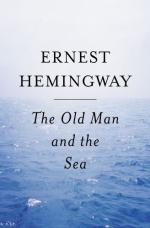|
|
Old Man and the Sea Author/Context
Ernest Hemingway was born in Oak Park, Illinois, in 1899. His father, Ernest Miller, was a doctor and also an avid hunter and fisherman. Ernest Senior introduced his son to the outdoors and took him to the Michigan woods on summer vacations. Hemingway was educated in the public schools and never continued his education past the high school level. At age 17, after he finished high school, Hemingway took a job as a reporter for the Kansas City Star.
Hemingway wanted to enlist in the army, but was rejected due to an eye injury he suffered when he was younger. Despite his rejection, Ernest still wanted to go to war and decided to travel overseas as a Red Cross ambulance driver. Hemingway was wounded in Italy during his duties with the Red Cross, just before he turned 19 years old. He was honored by the Italians for his bravery.
When Hemingway returned to the United States, he spent time in the Michigan woods, recovering from his war wounds, and later ended up in Toronto, where he worked as a reporter for the Toronto Star. Hemingway soon became dissatisfied with North American life and moved to Paris as a foreign correspondent for the Star. In Paris, he was taken under the wing of fellow Americans Gertrude Stein and Ezra Pound. Under their influence, Hemingway focused his attention on creative writing rather than reporting. It was during his time in France that he wrote his first published collection of short stories, In Our Time (1925), and his first novel, The Sun Also Rises (1926). He was only 27 when he published the novel and achieved fame.
After his first success in the literary world, Hemingway married and divorced three times. His fourth wife was Mary Welsh. During the 1930s he spent time in Spain and Africa and resided in Key West, Florida, where he gained a reputation as a sportsman and athlete. He fought bulls in Spain, hunted in Africa and fished in Florida. The main character of Santiago in Old Man and the Sea was based on someone he encountered during his fishing adventures on the Gulf Stream. While on his boat, he and his friend Carlos Gutierrez (the first skipper of his boat the Pilar) encountered a fisherman and a boy being dragged through the sea in a rickety boat, struggling against a big fish. The old man refused any help from Hemingway and his skipper. The story first appeared as an anecdote in an article in Esquire called "On the Blue Water," in April 1936.
The tale of the old, courageous fisherman is also said by critics to reflect the author himself. Gary Brenner described Santiago as the aging author Hemingway and the Marlin as his noble and beautiful published works. Others recognize Hemingway's love of gallantry. Sean O' Faolain is quoted by Carlos Baker as saying that Hemingway trotted the globe "in search of the flame of the spirit in men and beasts." In Old Man and the Sea, this flame is a characteristic of both Santiago and the Marlin.
In 1942, Hemingway volunteered himself and his fishing boat for Navy projects off the west coast of Cuba - a suicide mission to destroy U-Boats there for two years. He was also a correspondent on the loyalist side in the Spanish Civil War. In 1944 he went to England, where he worked as a correspondent and went on missions with the RAF (Royal Air Force). After D-Day, he joined the First Army. He suffered several injuries during World War II.
After the War, Hemingway lived in Havana until Fidel Castro's revolution forced him out of the country. Old Man and the Sea (1952) was Hemingway's last published work, and he received the Nobel Prize in 1954. After being kicked out of Cuba, he returned to Spain for one last rendezvous at the bullfights. Towards the end of his life, Hemingway suffered a lot of pain - high blood pressure, enlarged liver and faintness, depression and withdrawal. He bought a house in Ketchum, Idaho in 1961 where he planned to finally settle down. Ultimately, he was unable to endure his pain. Ernest Hemingway was driven to suicide on July 2, 1961.
Bibliography
Baker, Carlos. Hemingway: The Writer as Artist. Princeton: Princeton University Press, 1952.
Brenner, Gerry. The Old Man and the Sea: Story of a Common Man. New York: Twayne Publishers, 1991.
Fuentes, Norberto. Hemingway in Cuba. New Jersey: Lyle Stuart Inc, 1984.
Hemingway, Ernest. Old Man and the Sea. New York: Charles Scribner's Sons, 1952.
Unger, Leonard (Ed.). American Writers: A Collection of Literary Biographies, vol. 2. New York: Charles Scribner's Sons, 1974.
The Encyclopedia Americana, vol. 14. Danbury CT: Grolier, 1995.




